

Blackwater Treatment Onboard Cruise Ships Explained
Cruise ships house thousands of passengers and crew, which leads to enormous wastewater generation of up to 1000 cubic metres per day. Hence, Wastewater management has become a critical aspect of everyday operations.
A cruise ship needs to be self-reliant in this aspect, as it stays away from land for a considerable period of time.
Wastewater onboard cruise ships are categorised into two types, namely, greywater & blackwater.
Greywater comes from bathrooms, showers and washbasins. The water from galleys, meat rooms, fish rooms and laundries is also greywater. However, such water is called galley & laundry grey water for ease of differentiation.
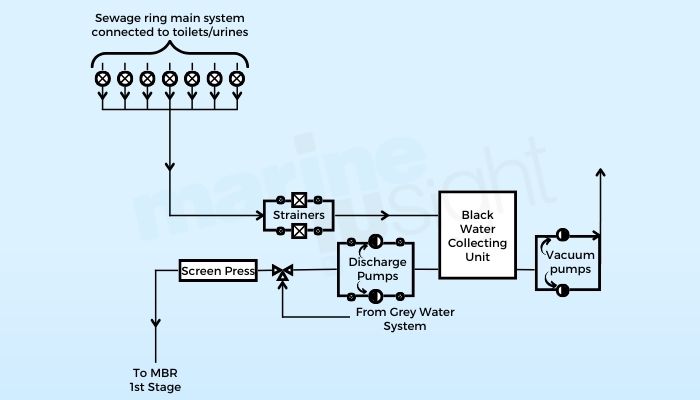
Blackwater is the dirty water from toilets and urinals, including flushed water. Since it consists of human waste, which is infectious & an environmental hazard, it needs special handling & treatment processes for its storage onboard or its discharge overboard outside ecological limits.
Therefore, our focus in this article will be on blackwater management, treatment and disposal.
Related reading:
Sewage Treatment Plant on Ships Explained
- 4 Important Terms Related to Sewage Treatment Plant on Ships
Blackwater Collection & Segregation/Pre-treatment
Blackwater is collected in blackwater collecting units via a ring-main system. The ring-main system is divided by various decks or zones onboard and connected to different blackwater collecting units.
There can be multiple numbers of collecting units (4-10 units) depending upon the size of the ship. They are usually installed in technical spaces throughout the ship, where technical staff can monitor and maintain them.
The blackwater is collected in the collecting tanks by gravity or vacuum. In the case of a vacuum system, the vacuum is generated in the collecting tank & its suction line using attached vacuum pumps which operate per the vacuum level through sensors.
The blackwater goes to the collecting units through coarse strainers, which must be cleaned daily or as per demand. These strainers remove any large-sized solids that may go to the collecting tanks, clog pipework or the discharge pumps.
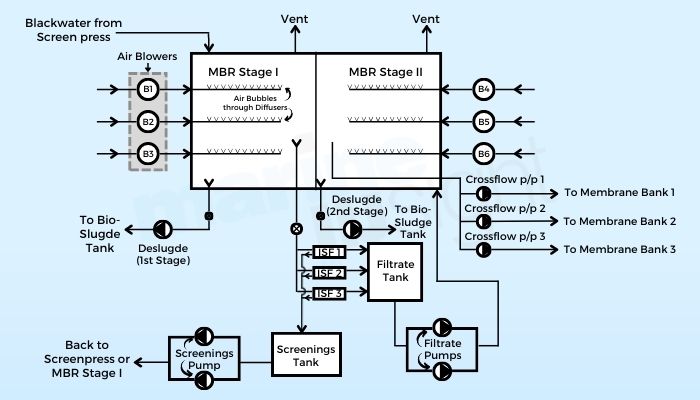
The blackwater collecting units have attached discharge pumps that are normally set to work on a timer but can also be set to work on the level. The pumps are operated by float switches and operate from time to time to lower the level of the blackwater collecting units. These pumps are sewage discharge pumps and transfer the blackwater from the collecting units to screen presses.
The screen presses further separate the solids, such as toilet paper, plastics, grit, fibres, rags etc., from the blackwater, thus ensuring that only the liquid passes through to the next stage, which is the treatment stage.
This is done by first separating the larger-sized solids by a mesh called a screen and, after that, removing the fine suspended solid impurities by a large screw shaft operated by a motor, which grinds and separates out the finer solids.
The screened or filtered blackwater passes through to the next stage, the treatment stage, whereas the separated solids from the screen press are collected in a separate tank, usually known as a Bio-sludge tank.
Accommodated greywater can also be fed to the MBRs along with blackwater. This process is automatically controlled as per demand, with the help of a 3-way valve at the inlet to the screen presses. At times of low blackwater generation, which is usually at night when most people are asleep, the 3-way valve supplies greywater to the MBR system to maintain the levels of the stages.
In the above case, the accommodation greywater is stored in separate double-bottom tanks. MBR greywater pumps are provided, which operate automatically as per the greywater demand from the MBR and the level of greywater in the DB tanks.
Treatment Process
The screened/filtered blackwater goes to the sewage treatment plant known as MBR. MBR stands for Membrane Bio-Reactor. As the name suggests, it treats sewage or blackwater through biological processes and membrane filtration.
The MBR has two stages. The blackwater from the screen presses comes to the 1 st stage, where aerobic bacteria treat it. A constant air supply generates aerobic bacteria through blowers and diffusers, which create air bubbles for evenly distributing the air throughout the biomass. Excess air, water vapour & gases are vented from both stages by attached vent lines to the atmosphere.
The aerobic bacteria act on the sewage, thus breaking it down & separating the sludge from the sewage water. The treated water now passes through to the 2 nd stage of the MBR, through the ISFs, which stands for Inter-Stage Filters.
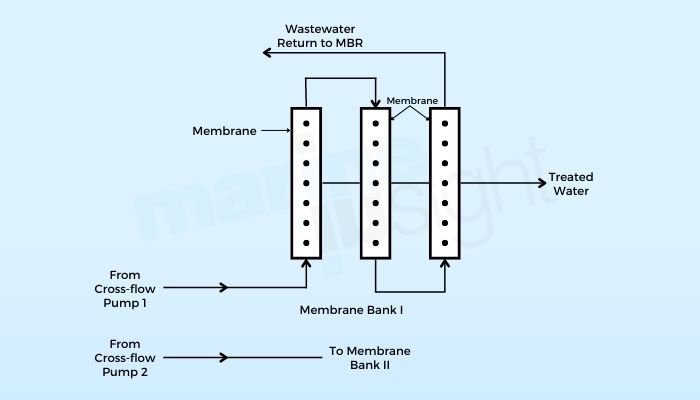
The ISFs help to remove any finer particles or impurities that may have been generated in the first stage or carried over from the pre-treatment stage. The filtrate from the ISF is collected in an attached filtrate tank, from where it is pumped to the 2 nd stage of the MBR by filtrate pumps, whereas the separated screenings (solids) collected in the screenings tank and are either pumped back to the screen press or the 1 st stage by the screening pumps. Both the filtrate & screenings pump has one operational pump & one standby pump.
The condition of the ISFs must be regularly checked, and the filters cleaned if required. The filtrate to screenings ratio is a parameter that indicates the health of the ISFs. Usually, the ratio should be between 1 and 5. Readings well outside this range will necessitate checks and/or adjustments.
Like in the 1 st stage, further aerobic action also takes place in the 2 nd stage. This is to ensure that sludge separation takes place as much as possible so that only liquid passes through to the membrane-filtration stage, thus reducing the possibility of membrane clogging and/or breakage, which can result in downtime and increased maintenance.
The separated sludge from both the 1 st stage & 2 nd stage must be removed daily to prevent the accidental carryover of the sludge along with the liquid to the membrane. There are separate sludge pumps and tanks which are provided for that purpose. Chemical dosing is also done in both stages for sewage sludge conditioning.
The liquid (wastewater) under treatment is pumped from the bioreactor’s 2 nd stage to the membranes by the centrifugal crossflow pumps. The membranes are usually arranged in multiple (usually 3 to 4) parallel banks. Each bank has several membranes in series & its crossflow pump. The individual banks can be isolated for cleaning or maintenance without disturbing the process.
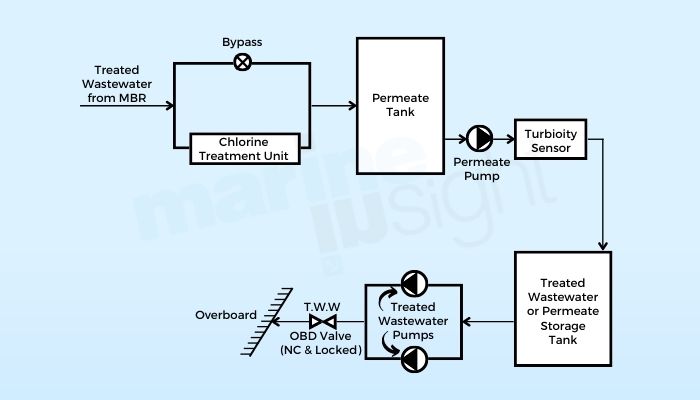
Each membrane is tubular, with 8 mm nominal bore tubes mounted onto 200 mm nominal diameter fibre-reinforced casings. The membranes are rated in the ultra-filtration range, with a nominal pore size of 40 nanometres.
There are several billions of such microscopic pores on the surface of the membrane fibre, which while forming a barrier to microbial impurities such as bacteria, viruses and protozoa, allow pure water molecules to pass through, thus affecting treatment. The untreated wastewater recirculates back to the bioreactor 2 nd stage.
The membrane banks, which foul due to accumulation of impurities, must be backflushed or flushed with clean freshwater once each day and chemically cleaned once a week for continued operational reliability and to avoid breakdown and damage to membranes. Membrane replacement can be a costly and time-taking affair.
The membrane-filtered liquid, known as permeate or treated wastewater, may be treated with chlorine for further disinfection before being pumped to permeate or treated wastewater storage tanks through a Turbidity sensor, which stops the permeate pump in case of high turbidity.
The stored permeate is pumped overboard, if & when outside of environmental limits, by treated wastewater pumps. Chlorine treatment (disinfection), in the case of MBRs, is not usually necessary if the bio-reactor & membranes are performing well.
Weekly tests must be performed for Biological/Chemical Oxygen Demand, smell, colour and E-Coli by taking samples from both stages of the bio-reactors permeate to ascertain the performance of the MBR plant.
While accommodation greywater can be supplied to the MBR, it is not advisable to use galley & laundry greywater, as the presence of detergents and/or oils can potentially be detrimental to the aerobic bacteria, thereby affecting biomass generation and function. For this reason, galley and laundry greywater also have their own separate storage tanks.
Blackwater management is a complex process that demands a comprehensive understanding of the system, strict attention to parameters, adherence to proper & timely maintenance procedures and accurate troubleshooting for continued efficiency and operational continuity.
The system’s complexity can also be a factor in the size of the ship. Bigger ships will put a considerable load in terms of operations & routines. Although designed to operate automatically and without manual assistance, systems are always prone to failure. It is advisable to follow manufacturer guidelines, manuals, maintenance schedules & regular testing to ascertain the plant’s health.
You might also like to read-
- The World Largest Cruise Line: Carnival Cruise Ships
- The Vista Class Queen Victoria Cruise Ship
- The Incredible MSC Fantasia Cruise Ship
- What are Polar Cruise Ships?
Disclaimer : The information contained in this website is for general information purposes only. While we endeavour to keep the information up to date and correct, we make no representations or warranties of any kind, express or implied, about the completeness, accuracy, reliability, suitability or availability with respect to the website or the information, products, services, or related graphics contained on the website for any purpose. Any reliance you place on such information is therefore strictly at your own risk.
In no event will we be liable for any loss or damage including without limitation, indirect or consequential loss or damage, or any loss or damage whatsoever arising from loss of data or profits arising out of, or in connection with, the use of this website.
Do you have info to share with us ? Suggest a correction
Latest Marine Technology Articles You Would Like :
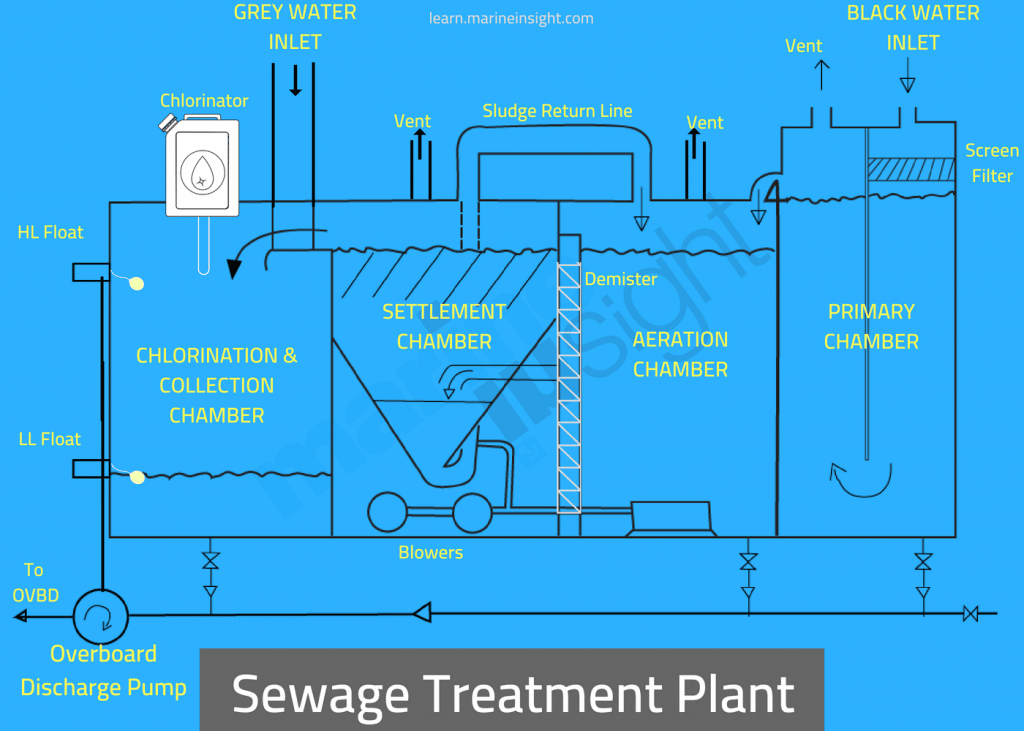
What is Eductor On a Ship?

What is an EchoSounder?

Practical Sample Kits by Normec MTS Allow the Crew to Take Water Samples Themselves

The Essential Guide to Bow Thruster Construction and Functionality

8 Biggest Ship Propellers in the World
Daily maritime news, straight to your inbox.
Sign Up To Get Daily Newsletters
Join over 60k+ people who read our daily newsletters
By subscribing, you agree to our Privacy Policy and may receive occasional deal communications; you can unsubscribe anytime.
Leave a Reply
Your email address will not be published. Required fields are marked *
Subscribe to Marine Insight Daily Newsletter
" * " indicates required fields
Marine Engineering
Marine Engine Air Compressor Marine Boiler Oily Water Separator Marine Electrical Ship Generator Ship Stabilizer
Nautical Science
Mooring Bridge Watchkeeping Ship Manoeuvring Nautical Charts Anchoring Nautical Equipment Shipboard Guidelines
Explore
Free Maritime eBooks Premium Maritime eBooks Marine Safety Financial Planning Marine Careers Maritime Law Ship Dry Dock
Shipping News Maritime Reports Videos Maritime Piracy Offshore Safety Of Life At Sea (SOLAS) MARPOL
WAIT! Did You Download 13 FREE Maritime eBooks?
Sign-up and download instantly!
We respect your privacy and take protecting it very seriously. No spam!
WAIT! Did You Download 12 FREE Maritime eBooks?

Beyond the Buffet: How Do Cruise Ships Get Rid of Human Waste?
By: Author David Chapman
Posted on Last updated: November 5, 2023
Categories CRUISE PLANNING , LEARN , ONBOARD EXPERIENCE
Cruises promise families a world of fun and adventure, from buffet extravaganzas to exotic shore excursions. But amidst the magic, there’s a logistical marvel often unnoticed: the management of waste on the high seas .
Specifically, how do cruise ships get rid of human waste? Let’s venture beyond the buffet to explore the systems in place that ensure both our comfort and the ocean’s health.

How Do Cruise Ships Get Rid of Human Waste: The Short Answer
Cruise ships deal with “ black water ,” which is human waste from toilets, clinics, and critter pens. All of this waste is packed with germs and junk, which, if tossed directly into the ocean, can definitely harm its ecosystem. Fortunately, rules and systems are in place to handle this procedure correctly.
Sewage treatment plants are among the systems used before discharging to combat and reduce pathogens and contaminants that blackwater can produce. Human waste collectively gets stored in holding tanks and most often gets disposed of in port facilities.
The Advanced Wastewater Treatment System (AWTS) is the most environmentally friendly procedure – using multiple processing stages to remove all the pollutants. This now “purified wastewater” is then either reused on the ship (not for drinking purposes) or responsibly discharged into the ocean or at a port facility.
But for more details on the fascinating process, read on.
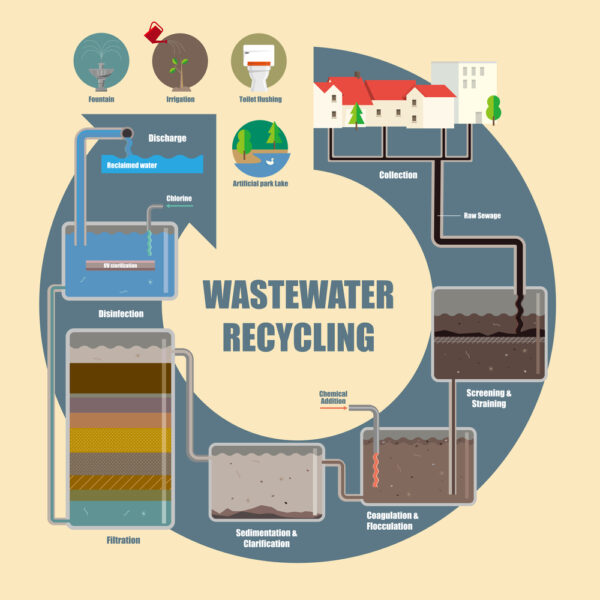
Cruise Ship Wastewater Separation: How Does It Work?
Cruise ships churn out tons of wastewater, and it’s not your regular H2O. Because they house so many passengers and crew, they can generate around 1000 cubic meters of wastewater daily . It mixes toilet material, kitchen muddles, chemicals, and debris from sinks and showers.
So, of course, there are rules categorized for the three types of wastewater:
- Black water – from toilets and kitchens – is often the collection of sewage, food particles, medical waste, and more. Cruise ships handle blackwater with tanks and pumps. They collect it by gravity or vacuum, with strainers to nab any solids. Attached pumps move it to screen presses, separating the gunk from the liquid for treatment.
- Grey water – from sinks and showers – is often a soapy and greasy collection. Cruise ships handle greywater with a hi-tech system. It screens out both the big and tiny debris, then uses bio and chemical approaches to clean it up. The result? Clean greywater that stays within nature’s limits.
- Bilge water – from what collects at the lowest part of the ship’s hull – is often the oily contraption from the ship’s engines, as well as a sludge buildup from seawater and freshwater leaking into the bilge wells. Bilge water on cruise ships goes through these steps:
- Collection: They gather it in the bilge wells, the ship’s basement, where the sides meet.
- Separation: Operators now run it through an Oily Water Separator (OWS), which cleans out oily stuff – some systems also use a triple-filter system.
- Measurement: They check it’s clean – less than 15 parts oil per million parts water.
- Discharge: Only clean water goes into the ocean far from the coast. The rest gets another cleaning round – some cruise ships even go the extra mile with two OWS systems for added environmental safety.
Most cruise ships, though, are incredibly innovative and recycle some wastewater for things like cleaning decks or flushing toilets. It saves on fresh water and helps the planet.
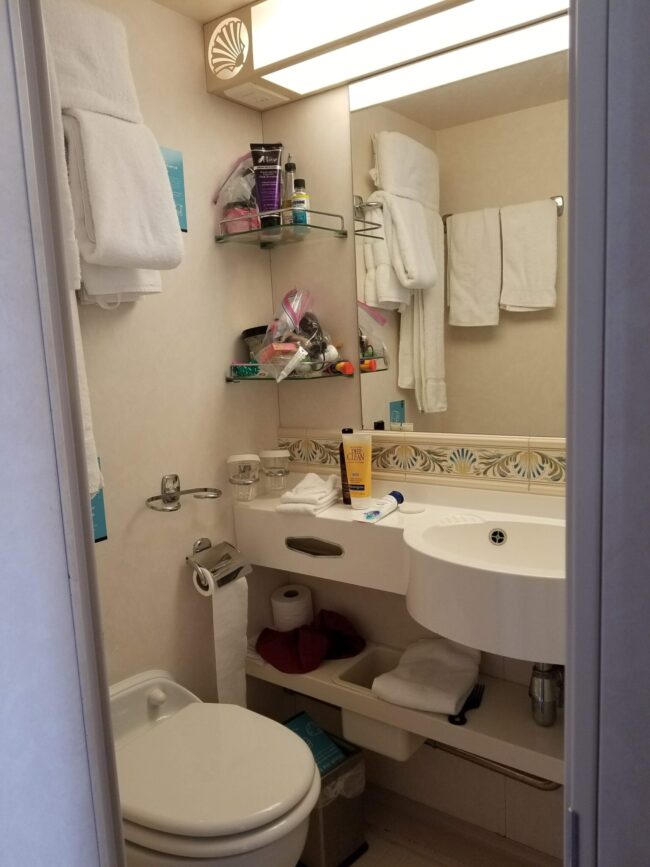
What Do Cruise Ships Do With Sewage?
Sewage, being a mix of wastewater and human waste, comes in either a liquid or solid state. Solid includes paper, plastic, food scraps – the bulky stuff. Liquid is water from sinks, showers, toilets, plus any chemicals.
The critical thing to remember here is that no ship can dump whatever they want, wherever they want. They are subject to criminal penalties if caught doing so. Cruise ships need to follow rules based on where they sail and what sewage they’ve got.
Solid waste gets its own tanks. It’s squeezed down and dried up. Some are burned on board, and some are offloaded for recycling or disposal. Records on how much solid waste is generated, as well as disposed of, is a mandatory requirement by law.
Liquid waste splits into greywater and blackwater groups. Greywater is legally allowed to be disposed of at sea just over three miles from land after it has been treated. Cruise ships handle their black water in two ways: at port or at sea. It’s a choice based on a few things: port facilities, location, rules, and how clean the water is.
- Port action: Some ships like to dock and hand off their black water to the land-based sewage system. It’s greener and follows strict rules in some spots. But not all ports are ready for it, and it can mess with schedules.
- At sea: Others go for ocean disposal, which saves time and money – but only under the correct conditions. If human waste is not treated correctly, it’s a no-go for the environment. Thus, strict rules apply here; maintaining a distance of 3.5 miles from shore according to US laws is one of them. But they all vary depending on the jurisdiction and environmental protection laws.
Who Enforces the Rules?
Several different agencies and departments actively work to monitor and enforce the rules regarding handling wastewater. These include the U.S. Coast Guard, the Environmental Protection Agency (EPA), and the Department of Justice.
Here are some notable examples of rules enforcement at work:
- Holland America Line Operating Company Agrees to Plead Guilty to Illegal Discharge of 20,000 Gallons of Untreated Sewage into Juneau Harbor (December 2004)
- Princess Cruise Lines to Pay $40 Million Fine for Illegal Dumping (December 2016)
- Carnival Cruises to Pay $20 Million in Pollution and Cover-Up Case (June 2019)
- Holland America fined $17K over greywater dumping in Glacier Bay (September 2019)
Black Water Treatment On Cruise Ships
Black water treatment on cruise ships is all about cleaning up sewage before it hits the ocean. Different ships use different sewage treatment plants (STPs) based on their size and design.
- Marine Sanitation Devices (MSDs): Old-school STPs that grind waste, disinfect with chlorine, and remove excess chlorine before releasing it – not excellent at reducing organic matter and may create nasty by-products.
- Membrane Bioreactors (MBRs): Advanced STPs that use biology and membranes to clean. Bacteria break down waste, membranes filter out the gunk, and UV light or ozone sterilizes it, producing top-notch clean water.
- Advanced Wastewater Treatment Systems (AWTS): The eco-champion of STPs. It has stages for separating solids, breaking down waste, removing contaminants, and recycling water for non-drinking purposes – saving up to 80% of water and reducing waste.
Behind the Scenes: Cruise Ship Kitchen Operations
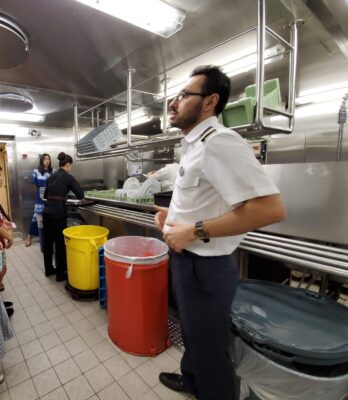
Understanding Advanced Wastewater Treatment On Cruise Ships
Cruise ships confront the challenge of wastewater, a complex mix of organic and inorganic contaminants that, if released untreated, can harm the marine environment and public health. To address this, vessels are equipped with sophisticated Advanced Wastewater Treatment Systems (AWTS) capable of purifying wastewater before it’s discharged into the sea.
AWTS represents a multi-faceted approach, leveraging biological, physical, and chemical processes for onboard wastewater treatment. The choice of AWTS type—whether membrane bioreactors, activated sludge systems, or reverse osmosis systems—depends on the vessel’s design and capacity. Nevertheless, all systems share common stages, including:
- Pre-treatment: This phase encompasses the removal of large solids, such as paper, plastic, and food scraps, through processes like screening, grinding, and filtering. These actions prevent potential clogging and damage to downstream treatment equipment.
- Biological treatment: Microorganisms like bacteria and fungi are employed to decompose organic matter and nutrients present in wastewater. These microorganisms metabolize organic material into carbon dioxide, water, and biomass. The biomass is subsequently separated from the treated water through sedimentation or filtration.
- Disinfection: Chlorination or ultraviolet radiation is applied to eliminate any remaining pathogens like bacteria and viruses within the treated water, ensuring its safety for discharge or reuse onboard.
- Post-treatment: This stage involves adjustments to the water’s pH, removal of excess chlorine, or the addition of chemicals to enhance the quality of the treated water, aligning it with international standards and regulations governing discharge or reuse onboard.
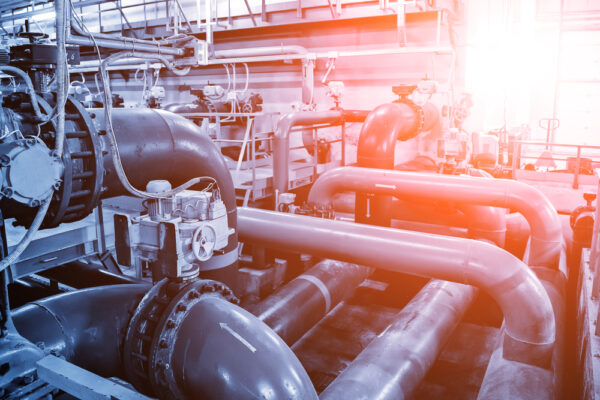
AWTS is engineered to produce effluent cleaner than what’s typically found in municipal wastewater treatment plants on land. Notably, the Cruise Lines International Association (CLIA) reports that 99% of new ships on order are equipped with AWTS, bringing the global capacity to 78.5%. Presently, 70% of the CLIA’s oceangoing cruise line fleet capacity relies on AWTS, marking a 5% increase over 2019.
The implementation of AWTS underscores the cruise industry’s dedication to environmental responsibility and innovation, minimizing its impact on marine ecosystems and safeguarding human health while providing an exceptional experience for passengers and crew members.
Do Cruise Ships Reuse Waste Water?
Cruise ships, those colossal floating cities, are thirsty for water. They use it for everything, but they can’t tap into pipes like on land. They either make their own from seawater or store it. And they’ve got to deal with the water mess left behind by passengers and crew.
Cruise ships work some water magic to stay in the good books of environmental regulations and be savvy with resources. They treat the water based on what it is.
Greywater gets cleaned up with physical and biological methods. Then, it’s used for things like flushing toilets or washing decks. Some high-tech ships take it further, making it safe to drink.
Black water needs a more complex treatment involving disinfection, nutrient removal, and sludge management. After that, it might find a new life for non-drinking uses like cooling the engine or getting released into the sea under strict rules.
And it’s not just about cleaning up. Cruise ships are water-saving champs. They use low-flow and air-powered faucets and teach passengers and crew to be water-wise. Every drop counts, and they even collect rainwater and AC condensation.
Treating and reusing water isn’t just about being responsible; it’s also a smart financial move and a nod to environmental stewardship.
How Cruise Ships Follow Environmental Standards
Cruise ships operate within a healthy framework of environmental strategies – demonstrating their dedication to environmental responsibility. Oversight from the major leagues like the International Maritime Organization (IMO), the US Environmental Protection Agency (EPA), and the European Union (EU) brings compliance to both national and international environmental laws.
For environmental sustainability, the pursuit starts with cruise ships committing to reducing global carbon emissions – aiming to achieve the IMO’s zero-emission target . They employ advanced tech and practices to boost fuel efficiency and reduce greenhouse gas emissions simultaneously – a must for the cruise industry.
These include next-gen air quality systems and propulsion systems applying liquefied natural gas (LNG) as the main focus. Still, more innovative moves towards the change include shore power connections, optimized hull designs, speed management, and energy conservation measures.
Operating in ecologically sensitive areas, like the Norwegian World Heritage Fjords, requires strict adherence to environmental regulations. Cruise ships must meet specific criteria regarding fuel sulfur content, nitrogen oxide emissions, water discharge from scrubbers, incinerators, black and grey water treatment, and anti-vapor plume devices.
More than just a fancy voyage – they tackle serious stuff too – waste control, clean ballast water, noise reduction, marine life care, and even educational programs. No ordinary gig!
Cruise lines adhere to industry best practices and standards as part of their ongoing commitment to reduce their environmental footprint and act as responsible ocean stewards.
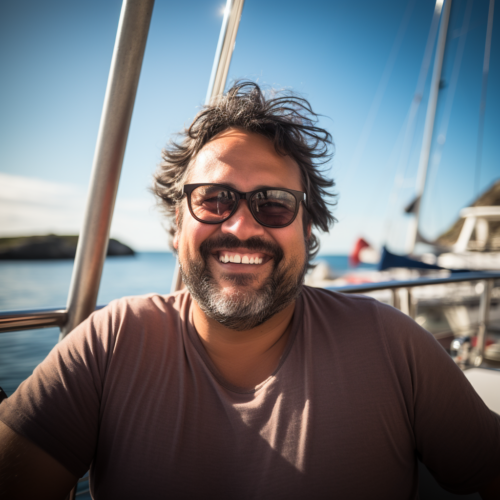
David Chapman
Contributor
Keep up with the latest cruise tips and insights! Follow us on Pinterest:
Related articles.

How do Cruise Ships Get Rid of Human Waste (the Poop)
Have you ever wondered what happens to human waste on a cruise ship?
Or perhaps been asked by a youngster, “where does poop go on a ship”?
Whatever your age, it’s a question many people wonder about.
Is it just dumped in the ocean, and would that be bad for the environment?
Or is it treated and disposed of responsibly?
With more and more cruise ships being built and seemingly getting ever larger it is certainly a question worth looking into because the amount of raw sewage produced equates to thousands of tonnes a year.

Some of the modern-day mega-cruise ships, including the largest Royal Caribbean cruise ships, can carry well over 6000 passengers and have over 2000 crew members on board. The Royal Caribbean Icon class cruise ships will be even larger.
Do Cruise Ship Toilets Drain Into The Ocean?
To prevent pollution of our marine environments, an IMO convention known as Marpol prohibits cruise ships from dumping or draining toilet water into the oceans.
Marpol Annex IV states:
“ the discharge of sewage into the sea is prohibited, except when the ship has in operation an approved sewage treatment plant or when the ship is discharging comminuted and disinfected sewage using an approved system at a distance of more than three nautical miles from the nearest land; sewage which is not comminuted or disinfected has to be discharged at a distance of more than 12 nautical miles from the nearest land. “ Source: imo.org
Where Does Waste Water On A Cruise Ship Go?
Wastewater on cruise ships is separated into two categories on a cruise ship gray water and black water. Toilet water is classed as black water and is treated onboard the ship. Only when the water is deemed safe is it released into the oceans according to specific guidelines.
On a cruise ship, these types of wastewater can be collected and stored in ballast tanks before both being treated separately onboard the ship, as we have outlined below.
Gray water is wastewater from
Although gray water doesn’t contain the harmful bacteria that black water does, it does contain a broader range of chemicals. Think of the laundry detergents, shower gels, shampoos, and sun lotions that people wash off their bodies.
This is one reason it is not mixed in with the black water because all these different chemicals could negatively affect the early treatment processes using live bacteria, which could be destroyed by unknown contaminants.
Gray water is filtered and discharged in permitted areas away from coastlines.
Sometimes the gray water is added to the final treatment stage of the blackwater when it is chlorinated.
However, it should be borne in mind that gray water is known to contain large amounts of microplastics, originating in particular from large of amounts of laundry, all the bedding, for instance.
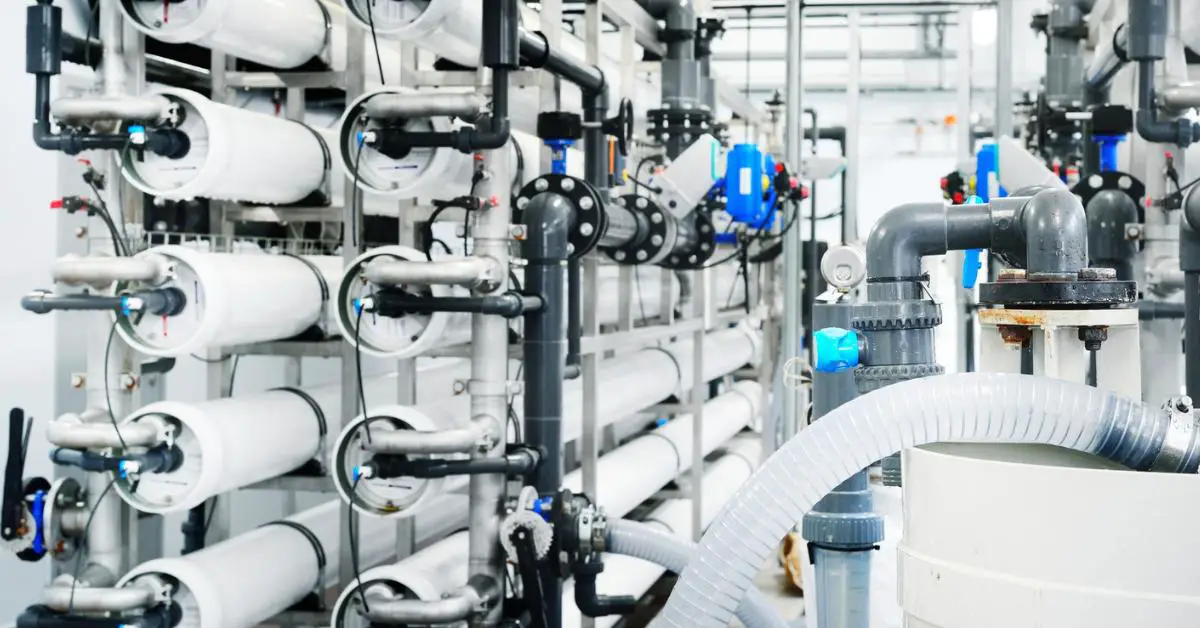
What Do Cruise Ships Do With Sewage?
Cruise ships treat raw sewage, otherwise known as black water, within a sewage plant in the engine rooms. It goes through a process of filtration, aeration, settlement, and sterilization before being safely released back in permitted sea areas.
Black Water
Black water is raw sewage discharge that contains or may have come into contact with some forms of solids (including poop). It’s mostly water from toilets .
This includes:
- Feces (poop)
- Toilet paper
Black water is dangerous because it contains harmful bacteria and viruses. It is also toxic due to the chemicals added to toilets and any holding tanks it is stored in.
If just released or dumped into the sea it will be environmentally harmful to marine life and also humans if it washes up upon coastlines.
What Do Cruise Ships Do With Black Water?
Both types of wastewater can be stored separately in ballast tanks in the bottom of the cruise ship’s hull.
Ballast tanks are used to help support a cruise ship and lower its center of gravity as well as being used for wastewater, they can be used to keep a ship upright in rough seas and are one means to prevent a cruise ship tipping over too far to one side.
Cruise ships have their own sewage works systems down in the engine room areas.
This is where all the collected black water is sent to be filtered and treated so it’s safe and could in theory, be reused. Much the same as sewage plants work on the land.
It is a 4 step process:
- Screen filtered into a sedimentation chamber (to remove any extra-large objects)
- Aeration – where it’s broken down by aerobic bacteria
- Settlement chamber – where sewage and water separates
- Sterilization – Water is chlorinated and sterilized
You can see an illustration of the process in the video below:
Although the raw sewage is fully treated onboard and results in clean potable water (drinkable), the water itself is not reused onboard. It is stored and later discharged in permitted locations.
Any leftover residues will eventually be safely disposed of ashore.
There are adequate suppliers of fresh water on a cruise ship when it disembarks to last the entire journey and more.

Carnival “Poop Cruise”
In 2013, a fire broke out in the engine room of Carnival Triumph (renamed Carnival Sunrise). Although the fire was extinguished, the events that unfolded led to the event being dubbed the now infamous “ Poop Cruise .”
The fire was quickly extinguished by automatic fire prevention systems in place. However, the event caused a loss of power, and the ship lost propulsion, so the ship was not moving.
Initially, passengers were relieved to be told the fire had been extinguished, and the crew was working in the engine room.
However, passengers soon realized the toilets were not flushing, which is a huge problem on a ship with about 4000+ people onboard.
The solution was to give passengers red plastic bags in which to poop and then leave in the corridors.
People who needed to urinate were told to pee in the showers. However, with the cruise ship’s stabilizers not working due to lack of power, the ship rocks from side to side. This resulted in the sewage overflowing from the showers onto the deck floors.
The whole event lasted five days and was subject to 24/7 news coverage.
Subsequently, this led to Carnival installing backup generator systems on all cruise ships in the fleet in an effort to prevent a disaster like this from ever occurring again on a cruise ship.
Further Reading:
- Why Is a Poop Deck Called a Poop Deck? (True Meaning)
- What do Cruise Ships do with Food Waste? (Is it dumped in the ocean?)
- Do Cruise Ships Dump Trash in the Ocean? (What do they do with the garbage waste?)
Frequently Asked Questions
Do cruise ships dump poop in the ocean.
Cruise ships are prohibited from dumping untreated sewage or “poop” into the ocean. Cruise ships are equipped with advanced sewage treatment systems that process black wastewater before it is discharged.
Is The Filtered Water On A Cruise Ship Recycled From Toilet Water?
Filtered water on a cruise ship is not recycled toilet water, or any other water from the ship. Toilet water is filtered and processed as black water. Once treated, it is released into the ocean in permitted locations only.

Where Does Toilet Water go on a Cruise?
Toilet water is treated as black water on a cruise ship. It is initially stored in a ballast tank before being treated via an onboard sewage plant in the ship’s engine room. Once the water is deemed safe, it is released into permitted ocean areas.
Related Posts

What is the Draft of a Cruise Ship? (and Why Does it Matter?)

How Many Doors on a Cruise Ship? (Yes, I Counted)
Leave a comment cancel reply.
Your email address will not be published. Required fields are marked *
Save my name, email, and website in this browser for the next time I comment.
What does a cruise ship do with human waste?
Home » What does a cruise ship do with human waste?
Last updated on July 11th, 2023 at 09:49 am
Older ships have in the past dumped human waste into the ocean once the ship was 12 nautical miles away from port, however this is a rare occurrence today, especially among the major cruise line operators.
Think of a cruise ship like a floating city. A floating city with it’s own wastewater management system.
Yes, you read that correctly – Most cruise ships are equipped with a modern wastewater management system onboard, complete with engineers who monitor the treatment of waste that goes down the drains and toilets on the ship.
A common misconception is that once a ship is out in the open ocean, they dump human waste into the water. This is simply NOT true today.
So, what happens to the human waste?
Cruise ships are equipped with water treatment systems that clean the human waste (black water) and grey water (water that goes down the sinks and showers), before it gets treated and combined and released back into the ocean. By the time this water is released back into the ocean, it has been cleaned enough to be safe for dumping into the ocean.
Any waste that can’t be processed as a solid is held until the ship returns to port or is incinerated.
All major cruise line operators belong to an organization called “CLIA” – Cruise Lines International Association. To maintain membership in this organization, cruise lines must adhere to a set of standards, including a Waste Water Management Policy that prohibits dumping of untreated waste at any time.
In addition to the regulations from CLIA, most cruise ships have a staff position onboard called “Chief Environment Officer” or something similar. This individual is responsible for ensuring the ship meets environmental requirements and is operating as clean as possible.
RECENT POSTS
Cruise news this week, what does it take to keep cruise passengers fed, royal caribbean cruise line loyalty programs: sailing to rewarding adventures, retirement home vs life at sea on a cruise ship, do i need travel insurance for a cruise, the pros and cons of cruising on a smaller cruise ship.
© 2023 cruiseportadvisor All Rights Reserved.
- Book Excursions
- Anchorage, AK
- Baltimore, MD
- Cape Liberty, NJ
- Charleston, SC
- Ft Lauderdale, FL
- Galveston, TX
- Honolulu, HI
- Jacksonville, FL
- L.A. (San Pedro), CA
- Long Beach, CA
- Montreal, QC
- New Orleans, LA
- Norfolk, VA
- NYC – Brooklyn
- NYC – Manhattan
- Port Canaveral, FL
- Quebec City, QC
- San Diego, CA
- San Francisco, CA
- San Juan, PR
- Seattle, WA
- Vancouver, BC
- Whittier, AK
- Alaska & Pacific Northwest
- Central & South America
- Cruise Ports in Bermuda
- Dominican Republic
- Mexico & Mexican Riviera
- Eastern Canada & Quebec
- New England
- Los Angeles (San Pedro), CA
- Fort Lauderdale, FL
- Cruise Blog
- Cruise FAQ’s

The Shipyard
For Those Who Love Ships
- Cruise Ships
How Cruise Ships Work (Part 1): Water and Waste Management
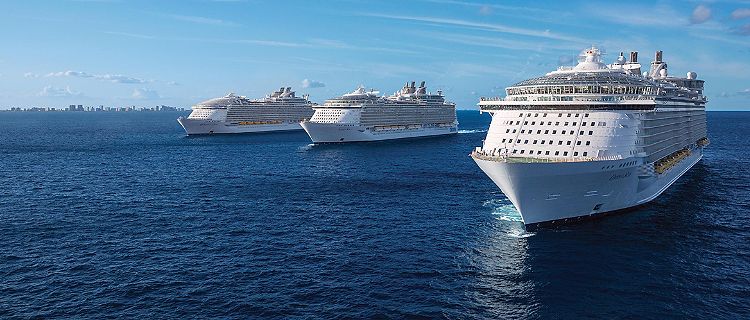
When cruise lines advertise their ships, they usually parade their most exotic travel destinations, their award-winning gourmet restaurants, their luxury cabins and lounge areas, as well as the non-stop entertainment they offer on board. We are rarely shown any photos of the plumbing system, the garbage storage and all the other service facilities that ensure that all that glamour on board stays glamorous.
Have you ever looked at one of those giant cruise ships that accommodate thousands of people and wondered, how on earth does this ship carry water for all of these people? What happens to all the disgusting sewage water? Where does all the stinky garbage go? As always, The Shipyard is here to answer.
All This Water and Not a Drop to Drink
The biggest cruise ship in the world, Royal Caribbean’s Symphony of the Seas , has a capacity of 6,680 passengers, each of whom uses on average between 200 and 250 liters of water per day. For a ship this size, this is a total of 1.5 million liters of water per day, for the passengers alone. There is no way in the world a ship could store so much water on board for the duration of the journey. So where does the water for the showers, sinks, cooking, etc. come from?

Cruise ships turn sea water to drinking water. Special pumps in the hull suck the raw water in and transfer it to the ship’s desalination plant. The plants are complex systems composed of water storage tanks, pipelines, pressure tanks and pumps. Two main methods are used to create fresh water: reverse osmosis and evaporation.
In the reverse osmosis process, a pump pressurizes the seawater and forces its molecules through a semi-permeable membrane. The result is called pure water permeate. Most dissolved salts, organic compounds, bacteria and suspended solids are larger than the mesh of the membrane and are unable to pass through.
In the alternative purification process, the H2O is evaporated from the seawater in specially designed evaporators, such as the Wärtsilä Serck Como multi-stage flash (MSF) evaporators in the picture below. Heat from the engine’s cooling water (75-95 ° C) is typically used as a source of heat for the evaporation process. The resulting condensate is then processed depending on the intended use.

After the water is desalinated through either evaporation or reverse osmosis, it is further mineralized and disinfected before it can be used as drinking water. Several methods for water disinfection are used on cruise ships including chlorination, ozonation, silver-ion treatment, UV radiation, filtration and heating up.
The resulting fresh water is stored in tanks, which are usually found in the hull of the cruise ships. With the aid of special pumps, the water finally reaches the end user in the bathrooms, laundry, the kitchen, etc. through kilometers of pipes that run through the ship. During the construction of the tanks, particular care is taken to protect the water from contamination. The plants achieve a quality of water that meets the drinking water standard on land.
Going Down the Drain – What Happens to Sewage Water?
Modern day cruise ships can carry several thousands of people who use the showers, toilets, pools and spa areas every day and all this results in astounding amounts of sewage material. Additional waste water is generated by the laundry, kitchen and other servicing facilities on board. Throughout the years, many cruise lines have been accused of dumping their wastewater directly into the ocean, but maritime regulations have changed in the recent past and all modern cruise ships are obliged to have their own wastewater treatment plant on board. To understand how it functions, let’s look at the four main types of wastewater on ships and how each type is processed.

Black Water
Black water is the first and most ghastly category. It refers to highly polluted waste water, containing fecal solids from the toilet system, bacteria, as well as traces of prescribed medications and hormones. To go from gruesome to golden, black water is treated in several steps – mechanically, biologically, as well as chemically. The first step is the mechanical treatment of the water, whereby coarse impurities (particles with a diameter of less than one millimeter) are mechanically filtered out. In the second step, the water goes through biological purification, where microorganisms decompose the organic matter. In the third step, the water runs through filters with extremely fine sifts (0.2 microns) that sort out all microorganisms. The filter membranes are advanced enough, so that no further disinfection of the water is necessary. The final step is nitrogen and phosphorus reduction. After all this treatment, black water may be disposed of overboard, if the ship is more than 12 nautical miles from land.

Grey water refers to most of the sewage on board, for example, from showering, bathing, washing hands, the laundry and the kitchen. Grey water is not as heavily polluted as black water, but still contains considerable amounts of pollutants, such as residues of personal care products, detergents or pharmaceutical products. On most ships it is therefore collected and treated together with the black water. According to current regulations, grey water may be dumped into the ocean 4 nautical miles from land.
Bilge Water
Bilge water may form in the lower part of the ship’s hull, the so-called bilge, for example due to condensate. Cruise ships have their own bilge water treatment system, which separates the gathered water from oil residues. The treatment of bilge water is extremely important, as even a small drop of oil can poison between 600 and 1,000 liters of water. The residues are separated from the water either mechanically, or chemically, and then transferred to special tanks. The separated oil residues are either burned on board or delivered ashore. The wastewater treatment plants on ships create by-products which are dehydrated and dried in a centrifuge. In order to prevent the reproduction of germs and to save space on board, the by-products are burned in an incinerator after they are dried. Once the ship docks, the ashes are disposed of with the remaining waste.
Ballast Water
Ballast water is taken in or expelled by seagoing vessels in order to increase the stability of the ship. The water is stored in appropriate ballast tanks and a quantity of up to 4000 cubic meters (141,258 cubic feet) is needed depending on the size of the ship. When seawater is sucked into the ballast tanks, small marine organisms, such as plankton, also get sucked in. When the ship sails to another location and expels its ballast tanks, these microorganisms are released into a foreign ecosystem, where they can spread rapidly and disrupt the balance of the existing ecosystem. To avoid this, ships are now obliged to filter and disinfect their ballast water through UV electrolysis or chemical treatment.
Where Has All the Garbage Gone?
16 tons of food waste are produced on average each week on a medium-sized cruise ship.

Since storage space on board is limited, a portion of the food leftovers is thrown overboard at the end of each day and ends up as fish food. This practice continues because food waste regulations are not as strict as those for sewage, for example. Despite the fact that food waste is theoretically not toxic to the environment, large quantities of it lead to the overfertilization of the oceans and fast algae growth, which in turn leads to a decrease in oxygen levels in the ocean. According to the International Maritime Organization (IMO) regulations, shredded food garbage may be released three nautical miles away from land. In certain special zones, the regulation states at least twelve nautical miles away from land. These regulations are often criticized for being outdated, as the passenger capacity on cruise ships, and therefore the quantities of garbage produced, has drastically grown in the past decade.
Cardboard, metals and plastics are collected and pressed together by hydraulic garbage compressors. Glass is crushed into small pieces by onboard crushing machines and then filled into large bags, each weighing a whole ton when full. Non-recyclable garbage is burned in incinerators and turned to ashes.

In the ports, the shipping companies then pass on the bundled waste packages to local disposal companies. The Marine Pollution Code of the IMO, states that no vessel or offshore platform may dump ashes from incinerators, oil from the kitchen or plastics into the sea, no matter the distance from land.
Part 2 Coming Soon…
In next week’s post , you can find out how the laundry rooms, the housekeeping, and the kitchens operate aboard a cruise ship.
Share this:
Leave a reply cancel reply.
Your email address will not be published. Required fields are marked *
Privacy Overview
- International edition
- Australia edition
- Europe edition

US cruise ships using Canada as a ‘toilet bowl’ for polluted waste
Lax Canadian regulations create ‘perverse incentive’ for US cruise ships en route to Alaska to discharge toxic mix of chemicals and wastewater off British Columbia, report says
F rom the comfort of cruise ships, a typical trip to Alaska offers magnificent views of glaciers and untamed national parks, and visits to quaint seaside towns. For years, these draws have made cruises to Alaska the most booked US holiday .
But the journey to those pristine areas, which involves sailing along Canada’s west coast for two or three days, is leaving behind a trail of toxic waste, including within marine protected areas (MPAs), according to new research.
More than 31bn litres (8.5bn US gallons) a year of pollution is estimated to be discharged off the west coast of Canada by cruise ships on their way to and from Alaska, according to a report by the environmental organisations Stand.earth and West Coast Environmental Law (WCEL).
“There’s this perverse incentive to treat Canada like a toilet bowl,” says Anna Barford, Canada shipping campaigner at Stand.earth. “They’re just using us like a highway and tossing stuff left, right and centre.”

Across Canada’s 151,019 mile (243,042km) coastline, ships generate 147bn litres of harmful waste each year, equivalent to 59,000 Olympic-sized swimming pools, according to a March 2022 report by WWF-Canada . Based on data from more than 5,000 vessels, the report found cruise ships were the largest polluters, despite making up only 2% of the marine traffic analysed.
Cruise ship pollution includes large volumes of toxic sewage from toilets, greywater from sinks, showers and laundries, and bilge water – the oily liquid that collects at the lowest part of a ship. By far the largest source of pollution identified in the WWF report was from so-called scrubbers – devices installed to remove exhaust gases such as sulphur oxide and nitrogen oxide, as well as particulates, from the heavy bunker oil used as marine fuel. The scrubbers create an acidic wastewater containing a cocktail of chemicals .
On a one-week trip to Alaska and back along the Canadian coast, a cruise ship will generate nearly 200m litres of waste from scrubbers, according to the Stand.earth and WCEL report. While ships can decide whether to discharge at sea or within a port, most waste from scrubbers is dumped as it is generated.
Globally, cruise ships have a patchy record of maintaining environmental regulations, including within Alaska , but the Pacific waters off the coast of British Columbia are particularly polluted. This is due to the many cruise ships but also because Canada’s federal dumping regulations are less stringent than the US laws , according to Michael Bissonnette, a lawyer from WCEL, particularly compared with regulations in Washington and Alaska – the two US states at each end of Canada’s west coast.

In Washington, more than 6,000 sq km (2,300 sq miles) of ocean habitat is protected in the Strait of Juan de Fuca and Puget Sound, near the Canadian border, and now classified as a no-discharge zone . Alaska requires cruise ships to apply for and receive permission to discharge sewage and greywater.
These regulations encourage ships “to hold on to their waste when they’re in American waters and then to dump it when they’re in Canadian waters”, Bissonnette says.
In Canadian waters, untreated sewage from cruise ships can legally be dumped outside a 12-nautical mile limit under vessel pollution regulations , which can often overlap into critical habitats . Meanwhile, treated sewage – which includes the waste from toilets and greywater from sinks and laundries – can be discharged three nautical miles from shore.
Sigrid Kuehnemund, vice-president of wildlife and industry at WWF-Canada, says that while each federal MPA has its own regulations, in Canada very few prohibit operational waste discharges – all the waste that accumulates onboard when ships are running. “The regulations that are protecting MPAs at the moment sort of give the shipping industry a free pass, and there aren’t clear regulations that would restrict dumping within those boundaries.”
There are efforts under way to tighten pollution rules. In April, on the eve of the new cruise ship season, the federal government department Transport Canada announced new measures to limit discharges of greywater and sewage from cruise ships operating in Canadian waters.
However, while welcome, the move is not enough, Bissonnette says, noting that the measures are voluntary and do not apply to scrubbers.

When released into the ocean, the wide array of toxic substances pose a significant threat to aquatic wildlife, and the habitat and food webs on which they depend, including threatened populations of sea otters and orcas that live off British Columbia’s coast.
About 10% of scrubber washwater discharged from ships off British Columbia occurred within critical habitats of orcas , according to an analysis by the International Council on Clean Transportation. Of particular alarm, says Kuehnemund , is the threat to wildlife in Scott Islands marine national park, a cluster of five islands off the north-western tip of Vancouver Island. This protected area is subject to the highest amount of pollution from cruise ship dumping, according to WWF’s report.

Lying on a busy route for cruise ships, the park holds some of the largest rookeries of Steller sea lions in the world. Each spring, more than 1 million seabirds – including 90% of Canada’s tufted puffins and half of the world’s Cassin’s auklets – breed on the island’s cliffs. Kuehnemund describes the area as “a biodiversity hotspot”.
There is fear in some coastal communities that as cruise ship traffic increases, so too will the threat to their waters. Popular port destinations including Victoria and Seattle have seen protests at the return of cruise ships after the lifting of pandemic restrictions.
The fishing communities of south-east Alaska also complain of dumped waste in their waters bordering Canada, fearing that critical fish species are being exposed to harmful substances.
One fisherman, Mark Severson, recalls in the summer of 2019 sailing through miles of foamy yellow waters in Petersburg, a small island community about 30 miles from the Canadian border and a popular port along the Alaska cruise route. Since then, Severson and his wife, Karen, have been advocating for stronger monitoring of waste dumping on cruise ships.
“The passengers that love the Alaska cruise do not even realise that the ships are polluting our pristine parts of the world,” he says.
With the new pollution measures in place, a spokesperson for Transport Canada said: “Canada is among the countries with the most stringent requirements for these types of discharges in the world.” The department said it recognised concerns regarding scrubber waste in Canadian waters and was working to develop approaches that could reduce discharge.
But Barford argues that only when Canada implements mandatory regulations will the problem of cruise ship pollution be tackled. “It’s a terrible way to say goodbye to a community that you’ve just visited,” she says. “Waving from the back as the ship empties out its tank. This is not something I would want to leave behind.”
- Seascape: the state of our oceans
- Marine life
Most viewed
- Alaska Insight
- Watch KAKM Live
- Indie Alaska
- Ways to Watch
- There is Hope
- AK Passport
- In My Family
- KSKA Schedule
- Hometown, Alaska
- Listen to KSKA Live
- All Radio Programs
- Outdoor Explorer
- Addressing Alaskans
- State of Art
- Alaska Economic Report
- Hear me now
- Military Voices
- One Small Step
- Alaska Morning News
- Talk of Alaska
- Alaska News Nightly
- Traveling Music
- Black History in the Last Frontier
- Latest News
- Environment
- Mental Health
- Rural Health
- Alaska Legislature
- Washington, D.C.
- Public Safety
- ANCSA, 50th Anniversary
- Midnight Oil
- Daily Digest
- AKPM Community Education Engagement
- Race Matters
- Ready to Learn
- Library Explorers
- Molly of Denali
- Learning Media
- Parent Resources
- Watch PBS KIDS
- Workforce Development
- Ways to Give
- Benefits of Membership
- Together We Are Stronger
- AKPM Merchandise
- E-Newsletters
- Organization
- Public Documents
- Public Meetings
- Accessibility Commitment
- Donor Portal

An up-close look at an advanced cruise wastewater system
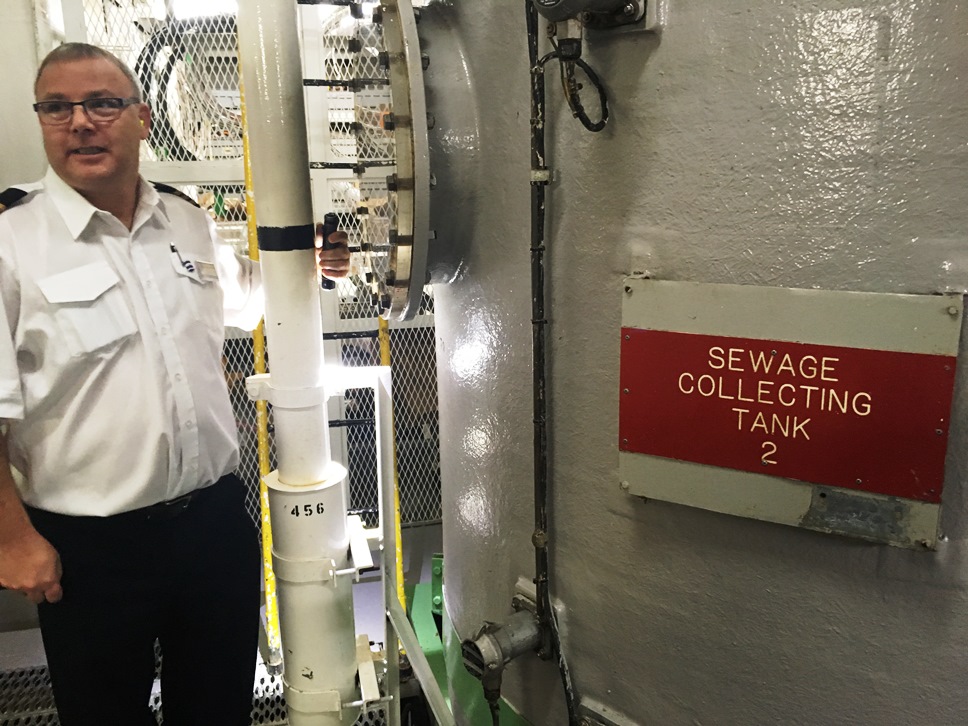
On one of Ketchikan’s rare sunny days this summer, a group of local residents gathered on the downtown cruise ship dock to board the Holland America ship Zaandam. The group had a fancy lunch on board, and then took a tour of not-so-fancy areas that most people never see: wastewater treatment, emissions filtration and garbage sorting.
After lunch, the group of Ketchikan business owners, elected officials, media and municipal employees watched a short video in one of the ship’s theaters.
“Every week on average, a cruise ship carrying 1,700 guests will produce up to 60,000 gallons of sewage,” the video’s narrator said.
It explained how much waste the floating cities produce, and what they do to manage it.
“We have an environmental officer on each of our ships, who provides environmental training and overseas shipboard compliance with environmental laws, regulations, industry standards and company policies,” the video continued.
Adrian Daniels is the Zaandam’s environmental officer. After the video, he took the tour through a door where opulence ends, and utility begins. Gone was the lush carpet, replaced with a painted metal floor. He walked up to a door with a key-card lock.
“We just going to go to the engine control room,” Daniels said. “Without stating the obvious, please don’t touch anything.”
About 95 percent of the ship’s automated systems are controlled from here, with three people minimum on watch at all times. Alexies Varon is the senior watchkeeper and is in charge of the ship’s wastewater plant.
“All the black water and gray water that comes from the cabins – is pumped by the jet pumps,” Varon said.
Blackwater is anything flushed in a toilet. Graywater is pretty much everything else – whatever goes down a sink or shower drain, for example. Varon explained that the Zenon-brand wastewater system mixes those, and treats both the same.
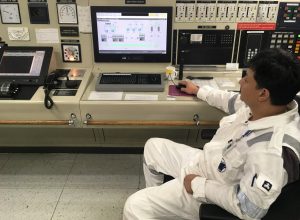
The water is sent into a filtration system to separate solids. The liquid is sent into a bioreactor and membrane filtration system to further filter impurities. Then, there’s a final step.
“It goes also on your UV filter to kill all the germs in there,” Varon said. “And then… it goes overboard or (we) keep it in the ballast tank to pump it outside 12 miles.”
The Zaandam, with its advanced wastewater treatment system, is one of the ships the state allows to discharge continuously, including when it’s docked next to a community. A local resident asked Daniels what is discharged in port.
“We discharge permeate,” Daniels said.
And what’s permeate?
“It’s been through the reactor. It’s been sterilized. It’s like clear water,” Daniels said. “It’s tested twice a month by laboratory and we have a random unannounced sampling as well to check for the criteria within that permeate.”
Daniels said that testing looks at levels of bacteria and dissolved metals. He said they meet international, federal and state regulations for discharge. And, he said, the permeate meets standards for drinking water.
But is that enough?
“That may be the case for human drinking water standards. But they may be releasing concentrated levels of metals that are completely intolerable to baby salmon, for example,” Michelle Ridgway said. She’s a marine ecologist who grew up in Ketchikan and now lives in Juneau – two of the largest cruise ship towns along Alaska’s Inside Passage.
Ridgway also was a member of the state cruise ship science and technical panel. In that role, she examined state regulations governing cruise waste and emissions, and procedures ships use to manage it.
While the science panel as a whole signed off on the state’s cruise ship wastewater regulations as adequate for marine life, Ridgway is concerned about discharge near shore and in port, even when the water is clear.
“Water can be crystal clear and contain quite a number of chemicals,” Ridgway said. “Heavy metals, such as copper, has been one of the constituents of the wastewater that’s of particular concern for us in Alaska.”
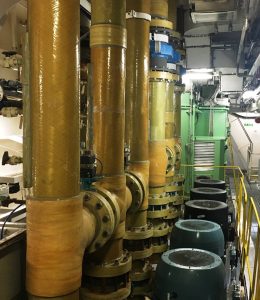
The science panel’s report notes that the state’s criteria for copper if 3.1 parts per billion. Cruise ships like the Zaandam are subject to state testing in addition to other tests.
But, Ridgway said even a little bit of copper can harm a salmon’s sense of smell. And they use smell to find their way back to the correct stream for spawning.
“We certainly know how much we like our king salmon. I don’t know about some areas in Southeast, but in the north area, we have seen a major decline in king salmon recently,” Ridgway said.
Ridgway said other marine animals are affected by dissolved metals. Krill is one example, and that’s an important food source for many ocean creatures, including whales.
Ridgway also questions how effective the systems are at removing tiny particles such as viruses and pharmaceutical residue.
So, what should the ships do to reduce their impact? Ridgway suggests cutting back on the amount of water used, along with continuing to improve on-board treatment systems. That includes more controls on temperature and acidity of wastewater, to make sure ships aren’t adding to ocean acidification or warming waters.
Ridgway said she’s definitely not anti-cruise ship.
“I was raised in the maritime and fisheries culture of Alaska,” Ridgway said. “I love ships and shipping, and I’m thrilled that people get to come to Alaska to enjoy wild Alaska.”
But, Ridgway said the cruise industry needs to do everything it can to maintain the wild Alaska that its customers come to see.
The cruise lines, at least according to the video, seem to recognize that, as well.
“Keeping the ocean safe and clean is good for the environment,” the video started. “It’s good for global ecosystems. It’s good for plant life; it’s good for animals; it’s good for our guests; it’s good for our crews; and it’s good for business.”
Leila Kheiry, KRBD - Ketchikan
Related articles more from author, anchorage mayoral runoff election: q&as with dave bronson and suzanne lafrance, anchorage’s lafrance-bronson mayoral runoff election is underway. here’s what to know. , key senators skeptical royalty relief proposals would boost cook inlet gas output.
Carnival reportedly dumped over 500,000 gallons of sewage and 11,000 gallons of food waste improperly in the year after it admitted to illegally releasing oil into the ocean
- A report from an environmental-compliance inspector says Carnival Corp. violated environmental laws in the first year after it reached a $40 million settlement for improper waste disposal.
- The inspector found over 800 violations of Carnival 's five-year probation between April 2017 and April 2018, though the violations were accidental and disclosed by Carnival, the Miami Herald reported.
- The report complimented Carnival's efforts to meet the terms of the 2017 settlement, saying the company had fixed the issues that led to the settlement.
- But the report also criticized the company's culture, internal investigations, and failure to give the inspector enough authority to ensure compliance with the settlement.
- Visit BusinessInsider.com for more stories.

A report from an environmental-compliance inspector says Carnival Corp. violated environmental laws in the first year following the company's $40 million settlement for improper waste disposal. The inspector found over 800 violations of Carnival's five-year probation between April 2017 and April 2018, though the violations were accidental and disclosed by Carnival, the Miami Herald reported.
The inspector wrote that Carnival illegally released over 500,000 gallons of sewage and over 11,000 gallons of food waste into water near ports and shores around the world, according to the Miami Herald. Other violations mentioned in the report include burning heavy fuel oil in restricted areas and creating false records about maintenance and training.
According to the Miami Herald, the amount of sewage released illegally comprised less than one percent of the total annual sewage created by all of Carnival's ships.
Related stories
"These issues were unacceptable failures in our processes that were not in accordance with our policies and procedures, and do not reflect the culture we have built at Carnival Corporation and across our nine cruise line brands," a Carnival representative told Business Insider. "We have been taking steps to address the improvement areas mentioned in the report, and to build on the positive progress noted by the court-appointed monitor to make sure we are in full compliance moving forward."
Read more: Carnival ships may get temporarily banned from docking in the US after the company was accused of violating the terms of a $40 million settlement, according to a report
The inspector's report complimented Carnival's efforts to meet the terms of its probation, saying the company had fixed the issues that led to the 2017 settlement.
"On balance, the Company has provided a high level of cooperation during ECP Year One," the report says.
But the report also criticized the company's culture, internal investigations, and failure to give the environmental-compliance inspector enough authority to ensure Carnival was following the settlement.
The 2017 settlement came after the Carnival subsidiary Princess Cruises pleaded guilty to illegally releasing oil into the ocean and deliberately hiding the practice. Princess was ordered to pay $40 million as part of the settlement. Carnival has since been on a five-year probation term, during which it must allow a third-party inspector to examine its ships.
The Miami Herald reported on April 10 that a federal judge said she may temporarily ban Carnival from docking its ships at US ports after prosecutors alleged that the company enacted a system designed to reduce the chances that the inspector would find any violations, according to the Miami Herald report. Carnival has reportedly said it ended the system by the end of 2017, but the prosecutors alleged that it was implemented in 2018.
Have you worked on a cruise ship? Do you have a story to share? Email this reporter at [email protected] .
- Sexual assault is the most common crime reported on cruise ships
- Cruise ship workers reveal the most disappointing things about their job
- A lawyer who reps cruise-ship workers reveals the most shocking thing he's heard about their job
- Here's how you can use your Costco membership to book a cruise
Watch: This Michelin Star restaurant recycles every scrap of food waste — here’s how
- Main content

Why grey water on board ships needs to be regulated
by Mariska Buitendijk | May 7, 2021 | Maritime regulations , News | 0 comments

The IMO’s MARPOL Annex IV is being revised to confirm the lifetime performance of sewage treatment plants (STPs) on board ships. This may finally bring about grey water regulation, a necessity that is long overdue according to Wärtsilä.
A ship’s sewage (black water) is collected from toilets, urinals and hospitals. The IMO’s MARPOL Annex IV prohibits its discharge, except when treated by an STP or discharged at >12 nm from the nearest land. A ship’s grey water, collected from showers, wash basins, laundries, and galleys, is not regulated.
Grey water has more pollutants (measured as BOD or COD) and hence greater environmental impact than black water (table 1) [1-4], but logical attempts to regulate grey water have been to no avail [5].

It has been widely acknowledged that the vast majority of approved STPs are discharging ‘virtually untreated sewage’ [6], and the regulation needs to be made effective. What may not have been recognised is that, for good technical reasons, an effective black water regulation may not be readily achieved without regulating grey water.
Most concentrated sewage vs. most stringent standard
For decades, marine regulators have assumed that a ship’s sewage is similar to sewage on land. It cannot be more wrong. A ship’s sewage is far more concentrated, since urban wastewater contains groundwater infiltration, rainwater, and grey water. Onboard vacuum collection systems push the concentrations even higher, making ship sewage the most concentrated across all industries (table 2) [1].

Yet, ship sewage is subject to more stringent Faecal Coliform limits when compared to the discharge standards around the world, including the EU land-based rules (table 3).

Even more so when it comes to the challenging nutrient standards. Under the Baltic Sea Action Plan [7], local communities of up to 300 population equivalent (p.e.) are not required to remove Total Phosphorus (TP). Conventional biological wastewater treatment plant (WWTP) on land can achieve the Total Nitrogen (TN) target of 35 mg/l or thirty per cent without introducing nitrogen removal technologies. As such, local communities of up to 10,000 p.e. are not required to remove Total Nitrogen (TN) (table 4).

This is not because the land-based industries are not ambitious, or that local communities don’t care. It is quite the opposite. They have evidence based, practicable, and sustainable environmental regulations that are enforced by performance monitoring (see figure below), whereby the goal is to protect environment, using best available technologies without entailing excess costs or adverse environmental impact. In contrast, passenger ships carrying as few as twelve passengers are given nutrient standards that are considered unnecessary, unbeneficial, and unviable by industries on land (table 4).

But are these sewage nutrient standards practicable? A ship’s black water can have nutrient concentrations ten times that of urban wastewater (table 5). There are other challenges. Ship operators can never be as familiarised with, or dedicated to, an STP as full-time operators in WWTPs. Ships have far less space and far poorer access and have real challenges in logistics and services. Plus, ships pitch and roll.

No one complained. The IMO’s type approval regime has made impossible tasks so ‘easy’ (see figure above). Ship owners who won’t trust a Bunker Delivery Note have embraced the certification of environmental technologies. Even those ships not suitable for nutrient removal have joined in, oblivious to the implications. It may not be a surprise that the first historical and courageous withdrawal of a certification under the MARPOL Convention was to an STP type approved for nutrient removal [8].
Conditioning vs dilution
The assumption of ship’s black water being similar to urban wastewater is evidently wrong. The assumption of ship’s black water can be readily processed to meet the most stringent standards is not evidence based. It is logical and essential to bring concentrations of black water closer to that of urban wastewater by “conditioning”. After all, most STPs are tested using urban wastewater that already contains grey water. Large STPs tested on board cruise ships included grey water [9,10]. Under Alaska’s successful permitting regime for cruise ships, grey water is regulated together with black water [11].
Without conditioning, the treated black water, by meeting only the percentage removal target, can still be too concentrated to be allowed into many territorial waters under the national rules. Untreated black water can be too concentrated to be legally received by even the public sewer of the port reception facilities.
Dilution, on the other hand, takes a big step in a wrong direction by using excess amounts of sea water to dilute pollutants, thus cheating the discharge standard.
Regulating grey water is a necessity
Regulating grey water together with black water makes the existing performance standard more attainable and practicable. Because grey water is often co-mingled with black water during storage and transfer on board, regulating grey water is essential for effective implementation of the proposed sewage record books.
There are other reasons too. For years, grey water related non-conformities have been persistent. Sending grey water to an STP’s final stage is a non-conformity wrongly approved and promoted by the classification societies since 2016 [12]. A ship’s grey water system is also becoming a dumping ground for regulated wastes, such as food waste and food waste derivatives, violating international marine rules and national biosecurity rules [13]. The interferences of grey water with the Ballast Water Convention also remain outstanding [14]. Regulating grey water can help to address these issues.
Regulating grey water can ultimately align the maritime industry to the rest of our society in protecting our coastal waters with integrated and consistent regulations, both on land and at sea.
Maritime industry needs evidence-based, practicable and sustainable environmental regulations. At a time when the MARPOL Annex IV is under revision, we can have the grey water issue raised and addressed in one hit, or we can have a piecemeal approach that drags on over decades. Which one is better for the industry, and the marine environment?
This article was submitted to SWZ|Maritime by Wärtsilä Marine.

- Dr Wei Chen, Future Program Development Manager, Wartsila Water Systems, UK (see picture)
- Mark Beavis IEng IMarEng FIMarEST, Sales Director, ACO Marine s.r.o., Czech Republic, ACO Marine Systems, Germany
- Oliver Jost, Maritime Environmental Affairs, Wasserschutzpolizei (Water Police) Hamburg, Germany
- Felix von Bredow, Board of Hamann AG, Hamann AG, Germany Markus Joswig, Head of Marine Department, PIA GmbH, Germany
Endorsed by:
- Benny Carlson, Chairman and owner, Marinfloc, Sweden
- Niclas Karlsson, Managing Director, Clean Ship Scandinavia AB, Sweden
- Ed White, Environmental Consultant, former Alaska DEC cruise ship compliance manager, USA
- Helge Østby, Senior Technical Advisor, Jets Vacuum AS, Norway
- Alex Myers, Chief Engineer, Sea Education Association, USA
- Antony Chan, MEng CEng MIMarEST, General Manager, Victor Marine Ltd., UK
- Sewage discharge to port – what to expect, by Dr E Dorgeloh, and M. Joswig, SOWOS 9, 2015.
- https://helcom.fi/wp-content/uploads/2020/01/Technical-guidance-for-the-handling-of-wastewater-in-ports.pdf
- https://www3.epa.gov/npdes/pubs/vgp_graywater.pdf
- https://oceanconservancy.org/protecting-the-arctic/take-deep-dive/grey-water-passenger-vessels-alaska/
- MEPC 72/INF.21, MEPC 72/16/6, DE 54/INF.5
- MEPC 71/INF.22, MEPC 74/14, PPR 8/7, PPR 7/16/1, PPR 8/7/4
- https://helcom.fi/media/documents/BSAP_Final.pdf
- https://www.linkedin.com/posts/wei-chen-05749a14_no-sludge-stps-activity-6770412800591376384-mtUq/
- MEPC 60/INF.4 (paragraph 7.3, 7.9, 7.11 and 7.19), 2009
- MEPC 67/8, 2014
- https://www.linkedin.com/feed/update/urn:li:activity:6761939034337017856/
- https://shipinsight.com/articles/vanishing-food-waste-flouts-maritime-and-national-law/
- MEPC 64/7/2; MEPC 64/7/7, MEPC 64/23, 2012
Submit a Comment Cancel reply
You must be logged in to post a comment.
Upcoming Events
Exhibition: rescuers at sea: 200 years of knrm, lng bunkering & future fuel global summit 2024, scandinavian maritime fair, argus green marine fuels conference, knvts lecture: research vessel wim wolff, knvts lecture: reducing container loss at sea, 14th international harbour masters congress 2024, breakbulk europe, maritime industry.

SWZ|Maritime articles
Curious about the articles in SWZ|Maritime? Some of them are published online. Read them here .
Is This a Picture of a Cruise Ship Dumping Human Waste Into the Ocean?
Apparently it's difficult to tell the difference between sand, mud, and human excrement from a distance., published feb. 1, 2019.

About this rating
An image supposedly showing a cruise ship dumping human waste into the ocean near a coastal city is frequently shared on social media. One popular iteration with more than 30,000 shares was posted by Facebook user Mena Anjos on 19 January 2019 along with the caption (translated via Google) "You know what this is? It's the discharges from the floating cities they call cruise ships":

A number of social media users commented and shared this image with more explicit descriptions of what it supposedly showed:
You know what this is? It's the discharges from the floating cities they call cruise ships...but it’s ok because tourism...looks like terrorism to me... The cruise ship @MSCCrucerosArg discharging its sewers in the port of Punta del Este... This is a cruise ship dumping excrement. You know what this is? It's the discharges from the floating cities they call cruise ships. Disgusting! Boycott until they discharge at port into a waste water treatment facility!
This is a genuine photograph showing two dark, brownish clouds in the waters surrounding a cruise ship, but it doesn't document that ship's dumping human waste into the ocean. Rather, it captures a cruise ship dropping anchor off the coast of Punta del Este, Uraguay.
After this image went viral in January 2019 (along with its unsavory claims about waste and pollution,) Alejandro Nario, Uruguay's National Director of the Environment ( Dinama ), took to Twitter to explain what the photograph actually depicted. According to Nairo, this image captured the cruise ship's starting up its turbines before dropping anchor, and thus the brown clouds visible in the water are sand and mud churned up from the water's bottom, not clouds of human excrement:
Ante consultas recibidas sobre esta imagen, aclaramos: fue tomada en el momento que están acomodando el barco para fondear, las turbinas de arranque producen turbulencia con las hélices, levantando arena y barro del fondo, en una zona de poca profundidad No se trata de efluentes pic.twitter.com/e2LQnTaG5W — Alejandro Nario (@alejandronario) January 11, 2019
How do these cruise ships, which can carry thousands of passengers and crew members on multi-day trips, actually dispose of their waste? A 2017 article from the Telegraph explained:
According to environmental regulatory lead at Royal Caribbean International, Nick Rose, the idea that cruise lines go round dumping stuff in the ocean is just wrong. “Our multi-stage treatment systems exceed the requirements of all international regulations,” he says. This is how it is done. For a start, there’s a lot of liquid to deal with every day. Even with aeration systems designed to reduce the amount of water coming out of bathroom taps and shower heads, the average ship will use average of 40-50 gallons per passenger per day. The “grey water” from galleys, laundries and bathrooms is first mixed in carefully measured proportions with the “black water” lavatory waste before bio reactors deep in the bowels of the ship set to work. There, all the nasty stuff is filtered out and digested by bacteria. The remaining liquid is disinfected by UV radiation rather than chlorine or other chemicals that would themselves be harmful to marine life. At this stage, and having been monitored for any remaining bugs such as faecal coliform, it is discharged into the sea “cleaner than the seawater that it might have started out as before being desalinated,” according to Rose. Because it is so clean, some ports have given approval for it to be discharged closer than the statutory 12 miles from land. About three tons of solids left from the original 1,200 tons of waste per day is incinerated or contained until it can be offloaded.
El Pais . "¿Qué Son Esas Manchas Que Se Ven Desde lo Alto Alrededor de Los Cruceros en El Este?" 11 January 2019.
Honeywell, John. "What Happens When You Flush the Loo on a Cruise Ship?" Telegraph . 1 February 2017.
By Dan Evon
Dan Evon is a former writer for Snopes.
- Share full article
Advertisement
Supported by
44-Foot Whale Found Dead on Bow of Cruise Ship Coming Into New York
The endangered sei whale, usually found in deep waters, was discovered on the bow of a cruise ship as it arrived at the Brooklyn Cruise Terminal, marine authorities said.

By Livia Albeck-Ripka
As the cruise ship approached New York on Saturday, it was found to be carrying a grim, and unexpected, catch: The carcass of a 44-foot-long endangered whale, draped across its bow.
The whale, which marine authorities described as a sei whale, is known for its rapid swimming and preference for deep waters, far from the coast. Its body was discovered as the ship neared the Brooklyn Cruise Terminal, and the authorities were “immediately notified,” said MSC Cruises, which owns the ship.
A spokeswoman for the company said in an email that it had “comprehensive measures” in place to avoid such collisions, including training deck officers and altering itineraries in certain areas to avoid them. “We will continue to evaluate and update our procedures with our partners and the authorities,” she said.
Marine authorities said that they had towed the animal, estimated to weigh some 50,000 pounds, from the bow, and transferred it by boat to a beach in Sandy Hook, N.J., where they conducted a necropsy on Tuesday.
The investigation is continuing, but preliminary results — broken bones in the whale’s right flipper; tissue trauma along its right shoulder blade; a full stomach and decent layer of blubber — all pointed toward the animal having been in otherwise good health when it was likely struck and killed by the ship, said Robert A. DiGiovanni, the chief scientist of the Atlantic Marine Conservation Society, which is leading the investigation .
The whale was already “pretty decomposed” by the time scientists began the necropsy, he added, so they worked quickly to collect samples that could be tested for contaminants and other biotoxins that would indicate any other relevant health issues. “It looks like the animal was alive and it was hit by a vessel,” he said, noting that investigators had not ruled out other factors.
Mr. DiGiovanni said that his conservation group, which is federally authorized to respond to marine mammal strandings in New York, had dealt with more than 100 whales over the past several years, many of which had been entangled in nets or struck by vessels. Most of those whales were humpback and North Atlantic right whales, he added, noting that it was more uncommon to come across a sei whale.
Sei whales usually live in subtropical, temperate and subpolar waters and are named after the Norwegian word for pollock, “seje,” because the mammals are often found together with the fish. Their long, sleek bodies are usually dark blue or black with a cream-colored underside, and are often scarred by shark and lamprey bites.
In the 19th and 20th centuries, the whales were commercially hunted for their meat and oil, decimating their population, which is now designated as depleted under the Marine Mammal Protection Act .
Mr. DiGiovanni said that the death was a reminder that humans shared the open water with many other mammals. “When you’re out there, these animals might be there,” he said. “We need to make people more aware about how to operate around these animals.”
A spokeswoman for the National Oceanic and Atmospheric Administration said by email that mariners along the East Coast were encouraged to slow down their vessels, stay alert, and report any sightings of dead, injured or entangled whales to the authorities.
Livia Albeck-Ripka is a Times reporter based in Los Angeles, covering breaking news, California and other subjects. More about Livia Albeck-Ripka
Watch CBS News
Cruise ship arrives in NYC port with 44-foot dead endangered whale caught on its bow
Updated on: May 9, 2024 / 11:41 AM EDT / CBS/AP
A cruise ship sailed into a New York City port with a 44-foot dead whale across its bow, marine authorities said.
The whale, identified as an endangered sei whale , was caught on the ship's bow when it arrived at the Port of Brooklyn on Saturday, National Oceanic and Atmospheric Administration fisheries spokesperson Andrea Gomez said. A necropsy conducted later confirmed the whale's species and determined that the creature was a mature female, said the Atlantic Marine Conservation Society, a nonprofit organization that conducted the exam on an marine mammal.
A spokesperson for MSC Cruises said the whale was on the MSC Meraviglia, which docked at Brooklyn before sailing to ports in New England and Canada.
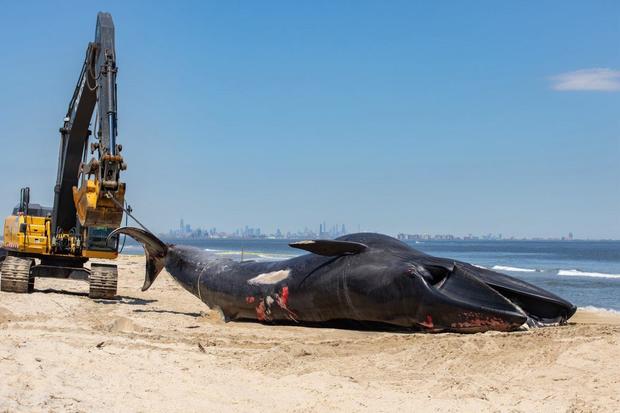
"We immediately notified the relevant authorities, who are now conducting an examination of the whale," officials with the cruise line said in a statement.
"We are deeply saddened by the loss of any marine life," the officials said, adding that the Geneva-based MSC Cruises follows all regulations designed to protect whales, such as altering itineraries in certain regions to avoid hitting the animals .
The dead whale was relocated to Sandy Hook, New Jersey, and towed to shore there to allow for better access to equipment and to conduct a necropsy, Gomez said.
The necropsy, an autopsy on an animal, was conducted on Tuesday, Gomez said. Samples collected from the whale will help biologists determine whether it was already dead when it was struck by the ship, she said.
Basic results of that exam showed evidence of tissue trauma in the area of the whale's right shoulder blade and a fractured right flipper, said the Atlantic Marine Conservation Society. In a post shared Wednesday to its Facebook page, the organization also said those tests revealed the whale's gastrointestinal tract was "full of food." Samples of its organs will undergo toxicology reviews and analyses to identify any potential tissue diseases.
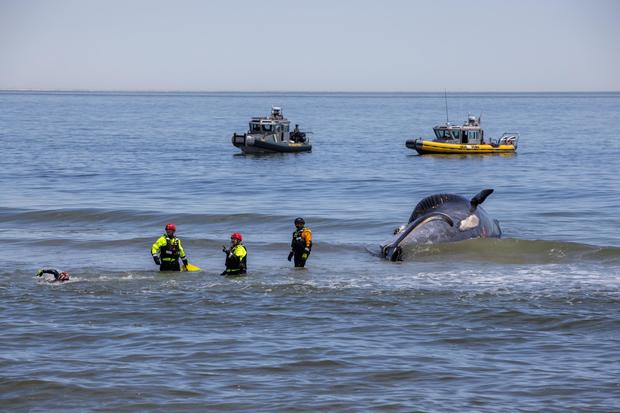
"The tissue and bone samples collected will help biologists determine if the vessel interaction occurred pre or post mortem," said the conservation society.
Sei whales are typically observed in deeper waters far from the coastline, Gomez said. They are one of the largest whale species and are internationally protected.
According to the New York Department of Environmental Conservation , sei whales eat 2,000 pounds of fish and plankton per day. They can grow up to 60 feet long, weigh as much as 50 tons and live on average between 50-70 years.
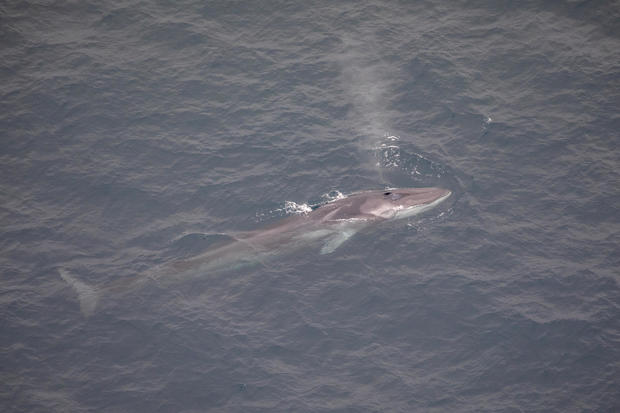
The incident marks the latest endangered whale to be found dead along the East Coast. Last month, federal authorities said a North Atlantic right whale that was found floating 50 miles offshore east of Virginia Beach, Virginia, was killed in a collision with a ship .
In March, NOAA said the first North Atlantic right whale baby born this season had died after being hit by a vessel .
Environmental groups have called for tighter regulations on commercial fishing and shipping to try to save the whales.
In Massachusetts, there's a proposal to put speed limits on fast ferries to Cape Cod and the Islands to protect whales. The ferry companies counter that this would drastically reduce service, and say their captains have never seen a right whale on the job.
- New York City
More from CBS News

Sean "Diddy" Combs asks judge to dismiss sexual assault lawsuit

How to watch the New York Knicks vs. Indiana Pacers NBA Playoffs game today: Game 4 livestream options

Rainn Wilson's new podcast shines light on spirituality

2 skiers killed, 1 rescued after Utah avalanche

Endangered 44-foot whale likely killed by massive cruise ship, dragged into NYC port: experts
A massive cruise ship likely struck and killed an endangered whale before sailing into the East River Saturday morning — and there’s no telling how long the dead mammal was dragged by the boat before it was discovered, according to marine experts.
The 44-foot adult female Sei whale was found as the MSC Meraviglia docked at the Port of Brooklyn, a spokesperson for MSC cruises confirmed.
The unlucky cetacean was removed from the 19-deck ship and towed to Sandy Hook, New Jersey, Tuesday for a necropsy, said National Oceanic and Atmospheric Administration fisheries spokesperson Andrea Gomez — but emphasized it is too soon to tell whether or not the whale was dead before impact.
Rob DiGiovanni, the founder and chief scientist of the Atlantic Marine Conservation Society, however, told The Post it was more than likely that the “interaction with the vessel contributed to her death.”
“It looks like she was eating,” DiGiovanni said, indicating she was a healthy whale with relatively fresh food in her stomach.
The hulking Meraviglia — the same ship that rescued 24 distressed Cuban migrants from a boat off the coast of Florida last year — weighs 171,600 gross tonage and stands 214 feet tall.
When and where the whale was struck remains a mystery, but Sei whales are typically observed in deeper waters far from the coastline, according to NOAA.
They are one of the largest whale species and are internationally protected, with vessel strikes listed as one of the biggest threats to its dwindling population.
The body was “pretty decomposed,” DiGiovanni revealed, but said that does not help professionals lock down a timeline of its death.
The temperature of the water, especially on the higher side, can accelerate the decomposition process by days.
The tragic event is unfortunately not uncommon, according to DiGiovanni, but it’s nearly impossible to track just how often it occurs because the whales could sink to the bottom of the ocean floor after being struck.
Ship staff or guests also might not even notice a striking, considering just how large cruise vessels stand, making even the world’s largest mammal look like an ant.
Such strikes could contribute to the unusual mortuary event in the New York Bight Apex — the waters from Fire Island to the Manasquan Inlet in New Jersey.
Starting in 2016, humpback, Mackey and North Atlantic Right whale deaths skyrocketed from one to three per year to 12 to 14 per year, DiGiovanni said.
The shocking death surge is a tragic side effect of whales flocking to Big Apple waters in higher numbers per year, creating a Catch-22 situation.
While some stay year-round, the amount of whales enjoying the East River jumps as spring rolls around.
“We start to see increases in whale sightings now, so we urge boaters to use caution in the waters,” DiGiovanni said, encouraging ship captains to consider the “Slow: Children at Play” mentality when taking on the open seas.
NOAA reiterated this sentiment: “Mariners operating along the US East Coast are encouraged to slow their vessel speed, stay alert, and report any sightings of right whales or any dead, injured, or entangled whales.”

Racial bias did not shape Mississippi's water funding decisions for capital city, EPA says
The U.S. Environmental Protection Agency says it found “insufficient evidence” that racial discrimination shaped decisions made by two Mississippi agencies about water system funding for the state’s majority-Black capital city of Jackson
JACKSON, Miss. -- The U.S. Environmental Protection Agency says it found “insufficient evidence” that racial discrimination shaped decisions made by two Mississippi agencies about water system funding for the state's majority-Black capital city of Jackson.
The EPA's Office of External Civil Rights Compliance issued its findings this week about the investigation it started in October 2022 into the Mississippi Department of Environmental Quality and the Mississippi State Department of Health.
The EPA announced its probe weeks after the national and state branches of the NAACP and nine Jackson residents filed a complaint alleging the state had a "practice of systematically depriving Jackson the funds that it needs to operate and maintain its water facilities in a safe and reliable manner.”
Jackson's water system nearly collapsed in late August 2022 after heavy rainfall and flooding exacerbated longstanding problems. Many people in the city of 150,000 lacked water for drinking, flushing or bathing for several weeks. A federally appointed administrator has been in charge of Jackson water since late 2022 and the federal government has approved $600 million for improvements to the city system.
The EPA wrote in its findings Monday that it investigated specific questions, including whether the Mississippi Department of Environmental Quality’s funding of water infrastructure and treatment programs is discriminatory.
The department's executive director, Chris Wells, said Wednesday that his agency was already following federal regulations.
“The evidence overwhelmingly shows that the Mississippi Department of Environmental Quality did everything right,” Wells said. “These allegations were entirely false and have been a distraction to the mission of our agency.”
The Health Department said in a statement that it is “committed to the equal opportunity for all counties, municipalities, districts and other water organizations” to have access to a loan program for water system improvements.
Derrick Johnson, national president of the NAACP, lives in Jackson.
“The NAACP is outraged at the inadequate findings presented by the EPA this week," Johnson said in a statement Thursday. "Since day one of this crisis, we have been on the ground, speaking with residents and community leaders. One thing remains clear — racial discrimination and neglect have left a majority Black, capital city in crisis."
Johnson said the NAACP hopes Mississippi government leaders will enact EPA’s recommendations, including that the Health Department assess its loan terms to ensure that communities with the greatest needs have access to water funding.
“The NAACP remains committed to using every tool at our disposal to ensure that all Black Americans have access to clean drinking water,” Johnson said.
The EPA examined state water fund loans to Mississippi communities between 1989 and 2021 and evaluated those based on the percentage of Black residents. Jackson's population was about 56% Black and 44% white in 1990, and the city's current population is about 82% Black and 15% white, according to the Census Bureau.
The EPA wrote that “funding for Jackson did not decrease as the racial composition of Jackson changed during the period analyzed" and the analysis found "no statistically significant relationship between loan amount and race across the state over time.”
The Department of Environmental Quality provided water loans to Jackson 13 times since 1990 — every time the city applied.
“Although Jackson falls on the lower end of per capita funding ... there was no significant relationship between loan amounts per person and race over time,” the EPA said.
The EPA also wrote that “the impacts of the water crisis fell disproportionately on the majority Black community of Jackson,” but “there is insufficient evidence to establish a relationship between the amount of funding disbursed by MDEQ to Jackson over time and the racial composition of the community.”
Jackson received three loans from a water improvement fund administered by the Health Department between 1997 and 2022, and the department told the EPA it never failed to approve completed applications from the capital city.
“For the years Jackson received loan awards, it received a large proportion of the total funding available for those years,” the EPA wrote.
Top Stories

Woman uses self-checkout to steal $60,000 of items from same Target store over a year
- May 10, 5:03 AM

At least 11 dead, mostly students, in Indonesia bus crash after brakes apparently failed, police say
- May 12, 12:50 AM

Controversy follows Gov. Kristi Noem as she is banned by two more South Dakota tribes
- May 11, 6:02 PM

Search on for suspect in fatal 'ambush' of police officer
- May 12, 1:36 PM
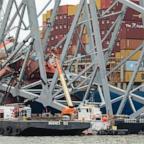
Removal of Francis Scott Key Bridge wreckage rescheduled due to lightning
- 3 hours ago
ABC News Live
24/7 coverage of breaking news and live events

COMMENTS
A cruise ship needs to be self-reliant in this aspect, as it stays away from land for a considerable period of time. Wastewater onboard cruise ships are categorised into two types, namely, greywater & blackwater. Greywater comes from bathrooms, showers and washbasins. The water from galleys, meat rooms, fish rooms and laundries is also greywater.
Cruise ships deal with " black water ," which is human waste from toilets, clinics, and critter pens. All of this waste is packed with germs and junk, which, if tossed directly into the ocean, can definitely harm its ecosystem. Fortunately, rules and systems are in place to handle this procedure correctly. Sewage treatment plants are among ...
Any water you bring on must be in carry-on luggage, not checked. Current mainstream cruise line water policies are as follows: Royal Caribbean Cruise Line allows up to 12 bottles, cans or cartons ...
Wastewater on cruise ships is separated into two categories on a cruise ship gray water and black water. Toilet water is classed as black water and is treated onboard the ship. Only when the water is deemed safe is it released into the oceans according to specific guidelines. On a cruise ship, these types of wastewater can be collected and ...
Cruise ships are equipped with water treatment systems that clean the human waste (black water) and grey water (water that goes down the sinks and showers), before it gets treated and combined and released back into the ocean. By the time this water is released back into the ocean, it has been cleaned enough to be safe for dumping into the ocean.
Cruise ship blackwater is collected from toilets, medical facilities, and even dishwashers (due to the grease content). The implications on our marine wildlife, waters, and coastal communities poses a concerning risk. As we explored above, wildlife including coral, marine mammals, sea turtles, and fish are directly affected by the vast amount ...
What is black water on a cruise ship? Black water is a term used to describe sewage. Typically, the term is explicitly used when describing human waste or water that has been in contact with some ...
Cruise ships turn sea water to drinking water. Special pumps in the hull suck the raw water in and transfer it to the ship's desalination plant. ... Black water is the first and most ghastly category. It refers to highly polluted waste water, containing fecal solids from the toilet system, bacteria, as well as traces of prescribed medications ...
Under section 312 of the Clean Water Act, the EPA and USCG regulate cruise ship discharges, including sewage, solid waste, ballast water (the water taken on board or discharged from a ship to maintain its stability), graywater (the wastewater from showers, sinks, laundries and kitchens), and the water that collects in the lowest part of the ship's hull, known as bilge water, which may contain ...
Black water is a term used to describe human wastewater within the maritime world, including by the cruise industry. Water that has come in contact with human feces, urine, or toilet paper is ...
Where your poop goes. Time to tackle my daughter's question of where your poop, shower water, and any other wastewater goes. Cruise ships have a water-treatment system onboard, similar to your hometown. With over 7,000 passengers and crew, Symphony of the Seas generates 210,000 gallons of black water and one million gallons of grey water during ...
Cruise ship pollution includes large volumes of toxic sewage from toilets, greywater from sinks, showers and laundries, and bilge water - the oily liquid that collects at the lowest part of a ...
The domestic sewage on ships can be divided into black and grey water, according to the sources. Black water is the sewage produced from restroom and medical facilities, while grey water is generated by bathroom, kitchen and laundry (Fig. 1).According to the water-saving measures on board, the sewage on ships is generally 2-3 times more concentrated than its land-based equivalent ...
Cruise ships generate a number of waste streams that can result in discharges to the marine environment, including sewage, graywater, hazardous wastes, oily bilge water, ballast water, and solid waste.They also emit air pollutants to the air and water. These wastes, if not properly treated and disposed of, can be a significant source of pathogens, nutrients, and toxic substances with the ...
Alexies Varon is the senior watchkeeper and is in charge of the ship's wastewater plant. "All the black water and gray water that comes from the cabins - is pumped by the jet pumps," Varon ...
The inspector found over 800 violations of Carnival's five-year probation between April 2017 and April 2018, though the violations were accidental and disclosed by Carnival, the Miami Herald ...
Ships can discharge untreated greywater in most waters of the world. My home state of Alaska is one of the few places that regulate greywater from large passenger vessels. Large cruise ships are bound by law to use advanced wastewater treatment systems to treat both greywater and sewage before discharging in state waters, and to meet sampling ...
Large STPs tested on board cruise ships included grey water [9,10]. Under Alaska's successful permitting regime for cruise ships, grey water is regulated together with black water [11]. Without conditioning, the treated black water, by meeting only the percentage removal target, can still be too concentrated to be allowed into many ...
A ship's black water can have nutrient concentrations 10 times that of urban wastewater (Table 5). ... Under Alaska's successful permitting regime for cruise ships, grey water is regulated ...
However, a master's thesis indicated a concentration of 2000-50 000 n L -1 from cruise ships, which was the highest concentration of microplastics (>50 μm) in any environmental media reported so far. Significant waste streams generated from ships are black water, gray water, and ballast water.
Boycott until they discharge at port into a waste water treatment facility! This is a genuine photograph showing two dark, brownish clouds in the waters surrounding a cruise ship, but it doesn't ...
May 2, 2022. Larger ships make up the vast majority of black carbon emissions, with container ships, bulk carriers and oil tankers emitting 60 percent of all BC emissions, according to the 2021 ...
In fact, gray water can contain many of the same contaminants as sewage, including fecal coliform bacteria and pose just as high of a public and environmental health risk as black water. Cruise Ship Water Discharge. On average, cruise ships discharge up 45 gallons of gray water per day per person.
May 8, 2024. As the cruise ship approached New York on Saturday, it was found to be carrying a grim, and unexpected, catch: The carcass of a 44-foot-long endangered whale, draped across its bow ...
A cruise ship sailed into a New York City port with a 44-foot dead whale across its bow, marine authorities said. ... A sei whale blows water off the coast of Kaikoura Peninsula, South Island, New ...
A massive cruise ship likely struck and killed an endangered whale before sailing into the East River Saturday morning — and there's no telling how long the dead mammal was dragged by the boat ...
The U.S. Environmental Protection Agency says it found "insufficient evidence" that racial discrimination shaped decisions made by two Mississippi agencies about water system funding for the ...